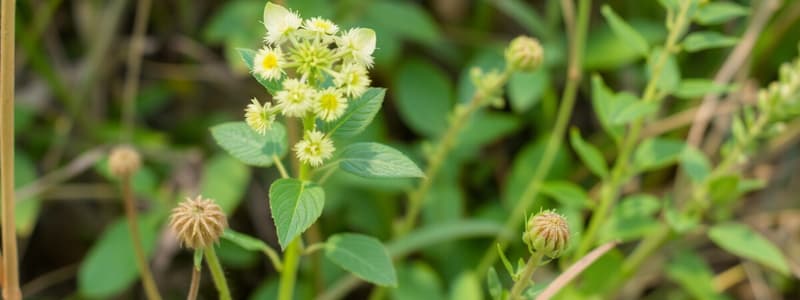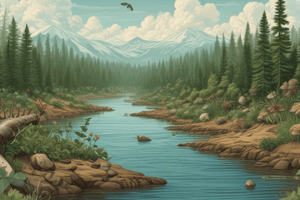Podcast
Questions and Answers
What is a primary consequence of climate change on ecosystems as highlighted in various studies?
What is a primary consequence of climate change on ecosystems as highlighted in various studies?
- Stabilization of habitat conditions
- Increase in biodiversity
- Alteration of species distribution (correct)
- Reduction in invasive species
What is the focus of habitat suitability modeling in relation to climate change?
What is the focus of habitat suitability modeling in relation to climate change?
- Identifying optimal environments for species (correct)
- Analyzing historical land use changes
- Predicting human population growth
- Mapping urban development
Which invasive plant is notably discussed in terms of its economic impact and ecological concerns?
Which invasive plant is notably discussed in terms of its economic impact and ecological concerns?
- Kudzu
- Leafy Spurge (correct)
- Purple Loosestrife
- Giant Hogweed
Risk assessment of alien plant distributions primarily seeks to evaluate what?
Risk assessment of alien plant distributions primarily seeks to evaluate what?
Which modeling technique is mentioned as useful for predicting alien plant invasions?
Which modeling technique is mentioned as useful for predicting alien plant invasions?
Economic assessments of invasive weeds like Leafy Spurge consider what aspect of their impact?
Economic assessments of invasive weeds like Leafy Spurge consider what aspect of their impact?
Invasive species can be influenced by climate change how?
Invasive species can be influenced by climate change how?
To what does the term 'niche-based modeling' refer in the context of plant invasions?
To what does the term 'niche-based modeling' refer in the context of plant invasions?
How might climate change affect native plants in areas previously occupied by invasive species?
How might climate change affect native plants in areas previously occupied by invasive species?
What type of restoration may be necessary due to climate change's impact on ecosystems?
What type of restoration may be necessary due to climate change's impact on ecosystems?
What is a potential consequence of not actively managing invasive species in changing climates?
What is a potential consequence of not actively managing invasive species in changing climates?
Which research approach is emphasized for addressing challenges arising from climate change and invasives?
Which research approach is emphasized for addressing challenges arising from climate change and invasives?
Why is integrated modeling important in the context of invasive species and climate change?
Why is integrated modeling important in the context of invasive species and climate change?
What is the significance of introducing species native to a larger ecoregion?
What is the significance of introducing species native to a larger ecoregion?
What might happen to habitats previously disturbed by invasive species if climate change continues unchecked?
What might happen to habitats previously disturbed by invasive species if climate change continues unchecked?
What is a key goal of transformative restoration planning in response to climate change?
What is a key goal of transformative restoration planning in response to climate change?
How does climate change create expanded risk for invasive species?
How does climate change create expanded risk for invasive species?
What potential benefit can arise from areas that become climatically unsuitable for currently invaded lands?
What potential benefit can arise from areas that become climatically unsuitable for currently invaded lands?
Which invasive plant is known for its significant impact on California grasslands and agricultural areas?
Which invasive plant is known for its significant impact on California grasslands and agricultural areas?
What role does the introduction of invasive species play in ecosystem functions?
What role does the introduction of invasive species play in ecosystem functions?
What major economic effect do invasive species like cheatgrass have on ecosystems?
What major economic effect do invasive species like cheatgrass have on ecosystems?
Which of the following species was intentionally introduced as an ornamental plant?
Which of the following species was intentionally introduced as an ornamental plant?
What is a key factor in projecting the range shifts of invasive species due to climate change?
What is a key factor in projecting the range shifts of invasive species due to climate change?
What common misconception might people have about the impact of invasive species on native plant populations?
What common misconception might people have about the impact of invasive species on native plant populations?
Flashcards
Climate change's effect on invasive plants
Climate change's effect on invasive plants
Climate change can alter the distribution and impact of invasive plant species.
Invasive plant distribution modeling
Invasive plant distribution modeling
Predicting the spread of invasive plants using computer models based on climate data and species characteristics.
Habitat, environment, and niche
Habitat, environment, and niche
The interplay of factors (habitat, environment) and how a plant occupies a specific role within an ecosystem (niche).
Cheatgrass dominance
Cheatgrass dominance
Signup and view all the flashcards
Economic impact of invasive weeds
Economic impact of invasive weeds
Signup and view all the flashcards
Presence-only methods
Presence-only methods
Signup and view all the flashcards
Extinction risk from climate change
Extinction risk from climate change
Signup and view all the flashcards
Alien plant invasions
Alien plant invasions
Signup and view all the flashcards
Climate change's impact on invasive plants
Climate change's impact on invasive plants
Signup and view all the flashcards
Transformative restoration
Transformative restoration
Signup and view all the flashcards
Invasive species competition
Invasive species competition
Signup and view all the flashcards
Interdisciplinary approach
Interdisciplinary approach
Signup and view all the flashcards
Species assemblages
Species assemblages
Signup and view all the flashcards
Native species re-occupation
Native species re-occupation
Signup and view all the flashcards
Modeling and experiments
Modeling and experiments
Signup and view all the flashcards
Envelope model fitness
Envelope model fitness
Signup and view all the flashcards
Invasive Species
Invasive Species
Signup and view all the flashcards
Climate Change Impacts
Climate Change Impacts
Signup and view all the flashcards
Ecological Restoration
Ecological Restoration
Signup and view all the flashcards
Cheatgrass (Bromus tectorum)
Cheatgrass (Bromus tectorum)
Signup and view all the flashcards
Spotted Knapweed (Centaurea biebersteinii)
Spotted Knapweed (Centaurea biebersteinii)
Signup and view all the flashcards
Tamarisk (Tamarix spp.)
Tamarisk (Tamarix spp.)
Signup and view all the flashcards
Leafy Spurge (Euphorbia esula)
Leafy Spurge (Euphorbia esula)
Signup and view all the flashcards
Range Shift
Range Shift
Signup and view all the flashcards
Study Notes
Climate Change and Plant Invasions: Restoration Opportunities
- Climate change can both increase and decrease the risk of plant invasions.
- Bioclimatic envelope modeling predicts range expansion and contraction for invasive plants.
- Yellow starthistle and tamarisk are likely to expand their range.
- Cheatgrass and spotted knapweed may shift, expanding and contracting in range.
- Leafy spurge is predicted to contract.
- Invasive species contracting could offer restoration opportunities.
- Identifying and establishing native or novel species in these areas is a significant ecological challenge.
Introduction
- Invasive plants are a major global concern, impacting ecosystems and increasing control costs.
- Invasive species risk is expected to increase due to climate change, enhanced competitiveness.
- Climate change, however, may reduce the competitiveness of some invasive plants if conditions become unsuitable.
- This could create opportunities for restoration.
- Previous research has identified expanded risks of some invasive plants due to climate change.
- Climate change impacts species distributions globally and regionally due to climate conditions.
Background
- Centaurea solstitialis (yellow starthistle) is an annual forb, a significant agricultural pest, and a water user.
- Tamarix species are shrubs often found in riparian ecosystems, displacing native plants and impacting water resources.
- Bromus tectorum (cheatgrass) is an invasive annual grass, leading to increased fire frequency and soil erosion.
- Centaurea biebersteinii (spotted knapweed) is a perennial forb, invading grasslands and outcompeting native species.
- Euphorbia esula (leafy spurge) is an invasive perennial herb dominating northern grasslands.
Materials and Methods
- Bioclimatic envelope models were constructed to analyze the relationship between invasive plant distributions and climate conditions.
- Plant distributions were based on regional and county level data including surveys and remote sensing.
- Non-native range data is used for invasive species climate envelopes.
- Climatic and competitive conditions in relation to native ranges are considered to predict invasions in non-native ranges.
- Climatic variables used include monthly and annual precipitation, minimum and maximum temperatures.
- Mahalanobis distance, a multivariate technique, was used to define species distributions within geographic areas.
Results
- Centaurea solstitialis are highly constrained by factors like summer and spring precipitation and winter/spring minimum temperatures.
- Climatically suitable areas for Tamarix spp. are widespread and little affected by climate change.
- Bromus tectorum climate suitable habitat shifts northward but reduces risk in other areas.
- Centaurea biebersteinii is impacted by factors like summer precipitation, minimum temperatures, and summer/winter temperatures.
- Euphorbia esula is influenced by winter precipitation, minimum temperatures, spring maximum temperatures, and annual precipitation.
Discussion
- Precipitation was the dominant climate variable affecting invasive plant distribution.
- Modeling using an ensemble approach from multiple Atmosphere-Ocean General Circulation Model (AOGCM) projections provides robust species projections.
Figures and Tables
- Figures illustrate distribution changes of the five invasive species and their potential response to climate change.
- Tables show the percentage of invaded areas with potential for restoration under future climate change scenarios.
Studying That Suits You
Use AI to generate personalized quizzes and flashcards to suit your learning preferences.




